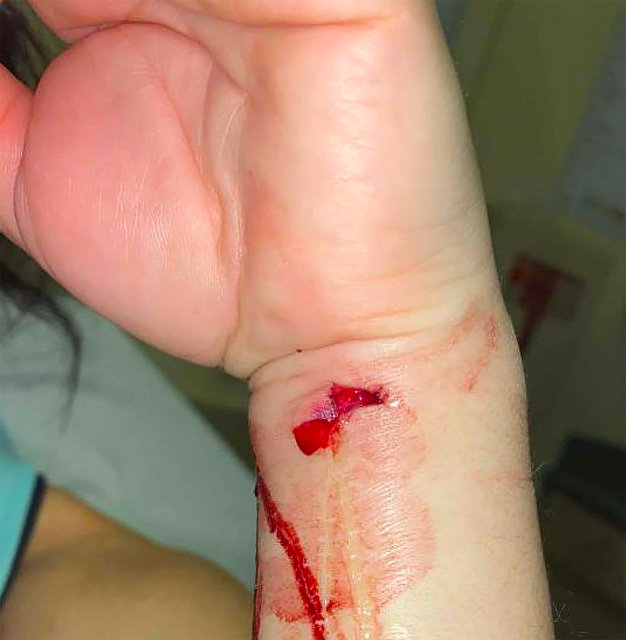A 38-year-old female with no pertinent past medical history presented to the emergency department after a koala bite to the wrist thirty minutes prior to arrival. She was bit on the left wrist on both the dorsal and volar aspect. Her pain was mild, without numbness or tingling. On initial exam, the patient had two lacerations. One was located on the dorsum on the radial side, and the other was located on the volar aspect near the ulnar side (figures 1-2).
Both were approximately 1.5 cm. Radial pulse was 2+. There was full ROM of the wrist and fingers with normal strength in flexion/extension. An X-ray was obtained to rule out any broken bones in the wrist given the surprisingly high bite force of the koala. The patient was given 15mg IM ketorolac and P.O. amoxicillin-clavulanate.
Shortly after the x-ray was obtained, the patient started to complain of worsening pain in her wrist that was not relieved with the ketorolac. Upon repeat evaluation, the patient was in moderate distress. She was holding her wrist in flexion and had severe pain with any wrist or finger extension. She had decreased sensation along the first, second and third digits, which was worse on the palmar aspect. After reading some case studies from Australia, the patient was given piperacillin-tazobactam to cover for Lonepinella species. Hand surgery was immediately consulted for concern of acute carpal tunnel syndrome. After examining the patient, surgery took the patient to the OR emergently.
In the operating room, the median nerve was noted to be compressed, and the transverse carpal ligament was incised. The flexor tendon tenosynovium was bathed in a large amount of clear fluid without purulence. The flexor tendon tenosynovium was edematous and had multiple adhesions on the tendon. It was also noted to have a gray discoloration. It was stripped and sent for culture. The wounds were irrigated thoroughly and closed. Symptoms improved immediately. The patient was placed on oral amoxicillin-clavulanate and discharged home two days later. At three months, she had regained all sensation and motor functions.
Acute carpal tunnel syndrome is a rare but rapidly emergent condition of acute the median nerve. It is typically seen in the setting of distal forearm fractures and trauma though other nontraumatic etiologies have been reported. It warrants immediate surgical consult and release (3).
It is most often encountered in the setting of wrist or forearm fractures and typically presents within hours of the injury. However, this case is extremely unique as there was no evidence of fracture, but there was evidence of flexor tendon tenosynovitis without purulence. This led us to wonder what could have caused this acute carpal tunnel syndrome and flexor tendon tenosynovitis.
The diet of the koala (figure 3) is mainly consists of eucalyptus leaves. These leaves are toxic to other animals and humans. The exact mechanism of the toxicity is unknown though it is thought to be related to the chemical cineole, a naturally occurring compound, which has been shown to have anticancer, antimicrobial, antioxidant, and anti-inflammatory properties.
In addition, the koala has developed a very distinct microbiome that enables it to digest these toxic leaves and compounds (1). There are several case reports from Australia of Lonepinella infection secondary to a koala bite (2). This is member of the Pasteurellaceae family. Culture of the tenosynovium did return positive for Lonepinella.
However, the series of events unfolded rapidly within minutes, and the majority of Lonepinella infections happened at a much slower rate. In addition to that, there was no evidence of purulence or frank infection in the OR. There was however, evidence of a rapidly progressing inflammatory response of the flexor tendon tenosynovium. The exact cause of which is unclear though it could be secondary to a reaction from the eucalyptus oil or some unidentified reactant in the saliva.
1: Blyton, M. (2020). What do koalas eat where and does this shape their microbiomes?: Royal society of Queensland research project, 2019. The Proceedings of the Royal Society of Queensland, 128, 201–202. https://search.informit.org/doi/abs/10.3316/informit.839601703055283
2: Sinclair HA, Chapman P, Omaleki L, Bergh H, Turni C, Blackall P, Papacostas L, Braslins P, Sowden D, Nimmo GR. Identification of Lonepinella sp. in Koala Bite Wound Infections, Queensland, Australia. Emerg Infect Dis. 2019 Jan;25(1):153-156. doi: 10.3201/eid2501.171359. PMID: 30561297; PMCID: PMC6302581. https://www.ncbi.nlm.nih.gov/pmc/articles/PMC6302581/
3: Genova A, Dix O, Saefan A, Thakur M, Hassan A. Carpal Tunnel Syndrome: A Review of Literature. Cureus. 2020 Mar 19;12(3): e7333. doi: 10.7759/cureus.7333. PMID: 32313774; PMCID: PMC7164699. https://www.ncbi.nlm.nih.gov/pmc/articles/PMC7164699/
Koala photo courtesy of M. Croucher, EMT






1 Comment
Very nicely interesting case scenario.